1. 说明文档中原有程序实现的功能、实现方法。(用语言、程序流程图、为原有程序添加注释等方式均可)
cpp
1.//const.h
2.//定义宏变量
3.#ifndef CONST_H
4.#define CONST_H
5.
6.#define TRUE 1
7.#define FALSE 0
8.#define ERROR 0
9.#define OVERFLOW -2
10.#define OK 1
11.#define MAXSIZE 20//队列中最多有20个元素
12.#define MAXLEN 100//字符串最大长度
13.
#endif
cpp
1.//Typedefine.h
2.//定义结构体
3.#ifndef TYPEDEFINE_H
4.#define TYPEDEFINE_H
5.
6.#include "const.h"
7.//字符串结构体
8.typedef struct{
9. char data[MAXLEN];//数据
10. int len;//数据长度,不算字符串结束字符"\0"
11.}SString;
12.//元素类型结构体
13.typedef struct{
14. SString* strName;//数据
15. long INumber;//号码
16.}Elemtype;
17.//结点结构体
18.typedef struct node{
19. Elemtype data;//结点的数据域
20. struct node *next;//结点的指针域,指向下一个结点地址
21.}SNode;
22.//队列结构体
23.typedef struct{
24. Elemtype q[MAXSIZE];//存放队列元素
25. int front;//队列头指针
26. int rear;//队列尾指针,存放尾元素的下一个位置
27.}Queue;
28.//栈结构体
29.typedef struct st{
30. Elemtype data[MAXSIZE];//存放栈元素
31. int top;//栈顶指针
32.}Stack;
33.
34.typedef int BOOL;
35.typedef int Status;
36.
#endif
cpp
1.//Queue.h
2.//定义队列的相关函数
3.#ifndef QUEUE_H_LY
4.#define QUEUE_H_LY
5.
6.#include "Typedefine.h"
7.#include <stdbool.h>
8.
9.Queue *InitQueue();//初始化队列函数
10.int EnQueue(Queue *Q, Elemtype x);//入队函数
11.int DeQueue(Queue *Q, Elemtype *x);//出队函数
12.int QueueEmpty(Queue Q);//判断队列是否为空,非空返回0,空返回1
13.int QueueCount(Queue *HQ);//统计队列元素个数
14.bool QueueFull(Queue Q);//判断队列是否满,满返回 TRUE,非满返回 FALSE
15.
#endif
cpp
1.//Queue.c
2.//队列的相关函数实现代码
3.#include "stdio.h"
4.#include "malloc.h"
5.#include "const.h"
6.#include "Queue.h"
7.#include <stdbool.h>
8.//队列初始化函数
9.Queue *InitQueue(){
10. Queue *Q = (Queue*)malloc(sizeof(Queue));//申请空间
11. Q->front = Q->rear = 0;//头尾指针相等时说明队列为空
12. return Q;//返回队列指针
13.}
14.//入队函数
15.int EnQueue(Queue *Q, Elemtype x){
16. if((Q->rear + 1) % MAXSIZE == Q->front) return FALSE;//队满,入队失败,返回0
17. else{
18. Q->q[Q->rear] = x;//存放元素至队尾
19. Q->rear = (Q->rear + 1) % MAXSIZE;//队列尾指针指向下一位
20. return TRUE;
21. }
22.}
23.//出队函数
24.int DeQueue(Queue *Q, Elemtype *x){
25. if(Q->rear == Q->front) return FALSE;//队空,出队失败,返回0
26. else{
27. *x = Q->q[Q->front];//从队头取出元素
28. Q->front = (Q->front + 1) % MAXSIZE;//队头指针指向下一位
29. return TRUE;
30. }
31.}
32.//判断队是否为空,非空返回0,空返回1
33.int QueueEmpty(Queue Q){
34. if(Q.rear == Q.front) return TRUE;//队空
35. else return FALSE;
36.}
37.//返回队列中的最后的一个元素
38.Elemtype Last(Queue *Q){
39. Elemtype *prElem = NULL;
40. Queue *prTempQueue;
41. prTempQueue = InitQueue();//初始化一个新的临时队列,用于暂存数据
42. while(QueueEmpty(*Q) == 1){//将Q中的元素依次取出放至prTempQueue中
43. DeQueue(Q, prElem);
44. EnQueue(prTempQueue, *prElem);
45. }
46. while(QueueEmpty(*prTempQueue) == 1){//将prTempQueue中的元素依次取出放至Q中
47. DeQueue(prTempQueue, prElem);
48. EnQueue(Q, *prElem);
49. }
50. return *prElem;//返回队列中的最后的一个元素
51.}
52.//判断队是否为满,满返回1,非满返回0
53.bool QueueFull(Queue Q){
54. if(((Q.rear + 1) % MAXSIZE) == Q.front) return TRUE;//队满
55. else return FALSE;
}
cpp
1.//exp1.c
2.//主程序,实现三个生产者与两个消费者问题
3.//在30s内,生产者把产品放入缓冲区,消费者从缓冲区中拿走产品,缓冲区空间定义为5,因为队列中元素最大值设为了20,所以无需考虑队列满情况。生产者在缓冲区满时必须等待,直到缓冲区有空间才继续生产;消费者在缓冲区空时必须等待,直到缓冲区中有产品才能继续读取。共有三个生产者与两个消费者线程,并将生产的商品放入队列中(商品编号从1000开始,最多放五个),根据先生产先消费的原则进行消费。
4.#include <stdio.h>
5.#include <stdlib.h>
6.#include <unistd.h>
7.#include <pthread.h>
8.#include <errno.h>
9.#include <sys/ipc.h>
10.#include <semaphore.h>
11.#include <fcntl.h>
12.#include "Queue.h"
13.#include "const.h"
14.#include "Queue.c"
15.
16.#define N 5//定义可用资源数量
17.
18.time_t end_time;
19.sem_t mutex, full, empty;
20.int fd;
21.Queue *qt;
22.Elemtype p;
23.void consumer(void *arg);
24.void productor(void *arg);
25.
26.int main(){
27. pthread_t id1, id2, id3, id4, id5;//创建5个线程,分别对应三个生产者与两个消费者
28. pthread_t mon_th_id;
29. int ret;
30. end_time = time(NULL) + 30;//程序执行30s停止
31. qt = InitQueue();//初始化队列qt
32. p.INumber = 1000;//号码从1000开始
33. ret = sem_init(&mutex, 0, 1);//初使化互斥信号量mutex为1
34. ret = sem_init(&empty, 0, N);//初使化empty信号量为N
35.
36. ret = sem_init(&full, 0, 0);//初使化full信号量为0
37. if(ret != 0) perror("sem_init");
38.
39. ret = pthread_create(&id1, NULL, (void*)productor, NULL);//生产者线程1
40. if(ret != 0) perror("pthread cread1");
41.
42. ret = pthread_create(&id3, NULL, (void*)productor, NULL);//生产者线程3
43. if(ret != 0) perror("pthread cread3");
44.
45. ret = pthread_create(&id2, NULL, (void*)consumer, NULL);//消费者线程2
46. if(ret != 0) perror("pthread cread2");
47.
48. ret = pthread_create(&id5, NULL, (void*)productor, NULL);//生产者线程5
49. if(ret != 0) perror("pthread cread5");
50.
51. ret = pthread_create(&id4, NULL, (void*)consumer, NULL);//消费者线程4
52. if(ret != 0) perror("pthread cread4");
53.
54. pthread_join(id1, NULL);//等待生产者线程1结束
55. pthread_join(id2, NULL);//等待消费者线程2结束
56. pthread_join(id3, NULL);//等待生产者线程3结束
57. pthread_join(id4, NULL);//等待消费者线程4结束
58. pthread_join(id5, NULL);//等待生产者线程5结束
59.
60. exit(0);
61.}
62.//生产者线程函数
63.void productor(void *arg){
64. int i, nwrite;
65. while(time(NULL) < end_time){//在规定时间内循环生产商品
66. sem_wait(&empty);//empty信号量P操作
67. sem_wait(&mutex);//互斥信号量P操作
68. if(TRUE == QueueFull(*qt)){//队满不操作
69. printf("Procuctor: buffer is full, please try to write later.\n");
70. }
71. else{//队不满
72. EnQueue(qt, p);//入队
73. printf("Productor: write [%d] to buffer\n",p.INumber);
74. p.INumber++;//编号加一
75. }
76. sem_post(&full);//full信号量V操作
77. sem_post(&mutex);//mutex信号量V操作
78. sleep(1);
79. }
80.}
81.
82.void consumer(void *arg){
83. int nolock = 0;
84. int ret, nread;
85. Elemtype p2;
86. while((time(NULL) < end_time) || (FALSE == (QueueEmpty(*qt)))){//在规定时间内或队列非空时,循环消费商品
87. sem_wait(&full);//full信号量P操作
88. sem_wait(&mutex);//互斥信号量P操作
89. if(TRUE == QueueEmpty(*qt)){//队列空,不能消费
90. printf("Consumer: the buffer is empty, please try to read later.\n");
91. }
92. else{//队列非空
93. DeQueue(qt, &p2);//出队
94. printf("Consumer: read [%d] from buffer.\n", p2.INumber);
95. }
96. sem_post(&empty);//empty信号量V操作
97. sem_post(&mutex);//互斥信号量V操作
98. sleep(2);
99. }
}2. 列出可改进的功能、实现方法等
可改进的功能:
- 将代码整理,去除掉了冗余代码。
- 显示缓冲区资源个数:创建全局变量n,统计生产者/消费者 生产/消费后缓冲区中剩余的资源个数,并予以显示。
- 提示生产者/消费者线程结束语句,如:Productor 1 is killed。
- 利用gettid()函数获得生产者、消费者的线程id,并显示是哪一个生产者/消费者 生产/消费 了哪一个商品。
- 编写了display()函数,根据生产者/消费者的动作,可视化了缓冲区中的商品状况,使商品变化情况更加简单直观。
- 利用for循环创建线程,实现可以自主输入想要创建的生产者与消费者个数(数值在1到10之间)、缓冲区大小(数值在1到20之间)与产品编号(数值在1到1000之间)。
- 编写了print()函数,优化了终端可视化界面,可在界面中选择功能并自定义赋值,使程序运行更灵活直观。
实现方法:
- 首先打印出终端可视化界面,让用户可以自主选择功能,可以进行自定义赋值、运行程序与退出系统操作,未进行自定义赋值的变量使用默认值。
- 自定义赋值后运行程序,根据用户的赋值给变量赋值,并创建生产者、消费者线程,运行生产者、消费者函数。
- 在生产者、消费者函数中,根据队列情况进行P、V操作与生产/消费操作,并利用gettid()函数获得生产者的线程id,显示是哪一个生产者/消费者 生产/消费了哪一件商品,并可视化生产/消费操作前后缓冲区中的产品变化情况与缓冲区中剩余的资源个数。
- 运行规定时间后生产者/消费者线程结束,退出系统。
3. 详细说明已完成的改进,附上程序代码,改进处加注释(注意代码格式)
cpp
1.//const.h
2.
3.#ifndef CONST_H
4.#define CONST_H
5.#define TRUE 1
6.#define FALSE 0
7.#define MAXSIZE 20
8.#define MAXLEN 100
#endif
cpp
1.//Typedefine.h
2.
3.#ifndef TYPEDEFINE_H
4.#define TYPEDEFINE_H
5.#include "const.h"
6.
7.typedef struct{
8. char data[MAXLEN];
9. int len;
10.}SString;
11.
12.typedef struct{
13. SString* strName;
14. long INumber;
15.}Elemtype;
16.
17.typedef struct{
18. Elemtype q[MAXSIZE];
19. int front;
20. int rear;
21.}Queue;
22.
#endif
cpp
1.//Queue.h
2.
3.#ifndef QUEUE_H_LY
4.#define QUEUE_H_LY
5.
6.#include "Typedefine.h"
7.#include <stdbool.h>
8.
9.Queue *InitQueue();
10.int EnQueue(Queue *Q, Elemtype x);
11.int DeQueue(Queue *Q, Elemtype *x);
12.int QueueEmpty(Queue Q);
13.bool QueueFull(Queue Q);
14.
#endif
cpp
1.//Queue.c
2.
3.#include "stdio.h"
4.#include "malloc.h"
5.#include "const.h"
6.#include "Queue.h"
7.#include <stdbool.h>
8.
9.Queue *InitQueue(){
10. Queue *Q = (Queue*)malloc(sizeof(Queue));
11. Q->front = Q->rear = 0;
12. return Q;
13.}
14.
15.int EnQueue(Queue *Q, Elemtype x){
16. if((Q->rear + 1) % MAXSIZE == Q->front) return FALSE;
17. else{
18. Q->q[Q->rear] = x;
19. Q->rear = (Q->rear + 1) % MAXSIZE;
20. return TRUE;
21. }
22.}
23.
24.int DeQueue(Queue *Q, Elemtype *x){
25. if(Q->rear == Q->front) return FALSE;
26. else{
27. *x = Q->q[Q->front];
28. Q->front = (Q->front + 1) % MAXSIZE;
29. return TRUE;
30. }
31.}
32.
33.int QueueEmpty(Queue Q){
34. if(Q.rear == Q.front) return TRUE;
35. else return FALSE;
36.}
37.
38.bool QueueFull(Queue Q){
39. if(((Q.rear + 1) % MAXSIZE) == Q.front) return TRUE;
40. else return FALSE;
}
cpp
1.//exp1.c
2.
3.#include <stdio.h>
4.#include <stdlib.h>
5.#include <unistd.h>
6.#include <pthread.h>
7.#include <errno.h>
8.#include <sys/ipc.h>
9.#include <semaphore.h>
10.#include <fcntl.h>
11.#include "Queue.h"
12.#include "const.h"
13.#include "Queue.c"
14.#include <sys/syscall.h>//使用gettid()函数所需要的头文件
15.#define gettid() syscall(__NR_gettid)//使用gettid()函数所需要的头文件
16.#include <string.h>
17.
18.time_t end_time;
19.sem_t mutex, full, empty;
20.Queue *qt;
21.Elemtype p;
22.int n = 0;//缓冲区中资源个数
23.int x = 2, y = 2;//生产者与消费者个数(默认值)
24.int ret;
25.int N = 5;//缓冲区最大资源个数(默认值)
26.
27.void consumer(void *arg);
28.void productor(void *arg);
29.void display();//可视化缓冲区中商品状况
30.void print();//终端可视化界面
31.
32.int main(){
33. p.INumber = 1;//产品初始编号(默认值)
34. while(1){
35. print();//展示系统可视化选项
36. //接收用户需要的功能号
37. char number[100];
38. ret = scanf("%s", &number[0]);
39. if(strlen(number)!=1 || ret != 1 || number[0] < '0' || number[0] > '5'){
40. printf("\nplease input a number between 0 and 5!\n");
41. continue;
42. }
43. int num = number[0] - '0';
44. //输入想要创建的生产者个数,并确保数值在1到10之间
45. if(num == 1){
46. do{
47. printf("Please input the number of productor: ");
48. ret = scanf("%d",&x);
49. if(ret != 1 || x < 1 || x > 10){
50. printf("Please ensure the input between 1 and 10\n");
51. }
52. }while(ret != 1 || x < 1 || x > 10);
53. }
54. //输入想要创建的消费者个数,并确保数值在1到10之间
55. else if(num == 2){
56. do{
57. printf("Please input the number of consumer: ");
58. ret = scanf("%d",&y);
59. if(ret != 1 || y < 1 || y > 10){
60. printf("Please ensure the input between 1 and 10\n");
61. }
62. }while(ret != 1 || y < 1 || y > 10);
63. }
64. //输入想要创建的缓冲区大小,并确保数值在1到20之间
65. else if(num == 3){
66. do{
67. printf("Please input the size of buffer: ");
68. ret = scanf("%d",&N);
69. if(ret != 1 || N < 1 || N > 20){
70. printf("Please ensure the input between 1 and 20\n");
71. }
72. }while(ret != 1 || N < 1 || N > 20);
73. }
74. //输入想要生产的产品的初始编号,并确保数值在1到1000之间
75. else if(num == 4){
76. do{
77. printf("Please input the key of product: ");
78. ret = scanf("%d",&p.INumber);
79. if(ret != 1 || p.INumber < 1 || p.INumber > 1000){
80. printf("Please ensure the input between 1 and 1000\n");
81. }
82. }while(ret != 1 || p.INumber < 1 || p.INumber > 1000);
83. }
84. //运行程序
85. else if(num == 5){
86. pthread_t id;
87. end_time = time(NULL) + 10;
88. qt = InitQueue();
89. //p.INumber = 1000;
90. ret = sem_init(&mutex, 0, 1);
91. ret = sem_init(&empty, 0, N);
92.
93. ret = sem_init(&full, 0, 0);
94. if(ret != 0) perror("sem_init");
95. //创建线程
96. for(int i = 0; i < x; i++){
97. ret = pthread_create(&id, NULL, (void*)productor, NULL);
98. if(ret != 0) perror("Productor pthread create");
99. }
100.
101. for(int i = x; i < x + y; i++){
102. ret = pthread_create(&id, NULL, (void*)consumer, NULL);
103. if(ret != 0) perror("Consumer pthread create");
104. }
105. //等待线程结束
106. for(int i = 0; i < x; i++){
107. pthread_join(id, NULL);
108. printf("Productor %d is killed\n", i);//提示程序结束语句
109. }
110. for(int i = x; i < x + y; i++){
111. pthread_join(id, NULL);
112. printf("Consumer %d is killed\n", i);//提示程序结束语句
113. }
114. break;
115. }
116. //退出系统
117. else if(num == 0){
118. break;
119. }
120. }
121. return 0;
122.}
123.
124.void productor(void *arg){
125. while(time(NULL) < end_time){
126. sem_wait(&empty);
127. sem_wait(&mutex);
128. if(TRUE == QueueFull(*qt)){
129. printf("Productor pthread %u: buffer is full, please try to write later.\n", gettid());
130. }
131. else{
132. EnQueue(qt, p);
133. display();//可视化缓冲区
134. n++;//缓冲区资源数加一
135. printf("------->");
136. display();//可视化缓冲区
137. printf("\n");
138. printf("Productor pthread %u: write [%d] to buffer.\n", gettid(), p.INumber);//利用gettid()函数获得生产者的线程id,并显示是哪一个生产者生产了哪一件商品
139. printf("There are %d left in buffer\n",n);//显示缓冲区中剩余的资源个数
140. printf("--------------------------------------------------\n");//生产者/消费者动作分隔符
141. p.INumber++;
142. }
143. sem_post(&full);
144. sem_post(&mutex);
145. sleep(1);
146. }
147.}
148.
149.void consumer(void *arg){
150. Elemtype p2;
151. while((time(NULL) < end_time) || (FALSE == (QueueEmpty(*qt)))){
152. sem_wait(&full);
153. sem_wait(&mutex);
154. if(TRUE == QueueEmpty(*qt)){
155. printf("Consumer pthread %u: the buffer is empty, please try to read later.\n", gettid());
156. }
157. else{
158. DeQueue(qt, &p2);
159. display();//可视化缓冲区
160. n--;//缓冲区资源数减一
161. printf("------->");
162. display();//可视化缓冲区
163. printf("\n");
164. printf("Consumer pthread %u: read [%d] from buffer.\n", gettid(), p2.INumber);//利用gettid()函数获得消费者的线程id,并显示是哪一个消费者消费了哪一件商品
165. printf("There are %d left in buffer\n",n);//显示缓冲区中剩余的资源个数
166. printf("--------------------------------------------------\n");//生产者/消费者动作分隔符
167. }
168. sem_post(&empty);
169. sem_post(&mutex);
170. sleep(2);
171. }
172.}
173.//可视化缓冲区中的商品状况
174.void display(){
175. printf("[");
176. for(int i = n; i > 0; i--){
177. printf(" P ");
178. }
179. printf("]");
180.}
181.//终端可视化界面
182.void print()
183.{
184. printf("\n");
185. printf("*********************************************************************************\n");
186. printf("--------------------[ Producer Consumer Program Function Bar ]-------------------\n");
187. printf("*********************************************************************************\n");
188. printf("* 1.Enter the number of producers you want to create (default value is 2) *\n");
189. printf("* 2.Enter the number of consumers you want to create (default value is 2) *\n");
190. printf("* 3.Enter the buffer size you want to create (default value is 5) *\n");
191. printf("* 4.Enter the initial product number you want to produce (default value is 1) *\n");
192. printf("* 5.run the program *\n");
193. printf("* 0.Exit the system *\n");
194. printf("---------------------------------------------------------------------------------\n");
195. printf("Please enter 0-5 to select a function: ");
}4. 运行结果截图
(1)示例一,这次运行我们想将生产者改为2个,消费者改为4个,其余选项为默认值,运行程序。
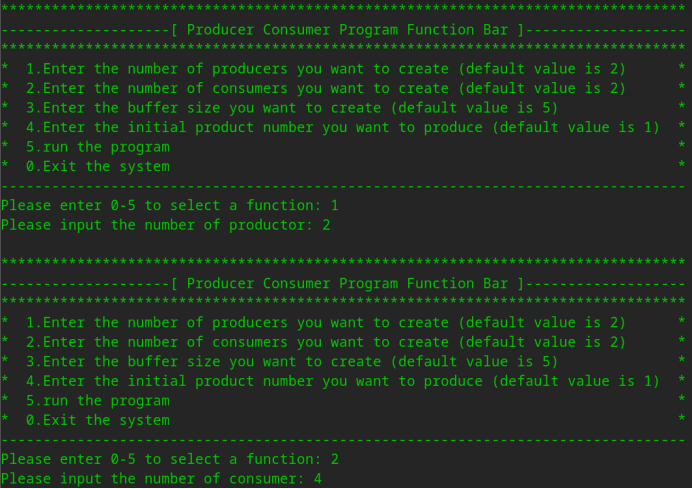
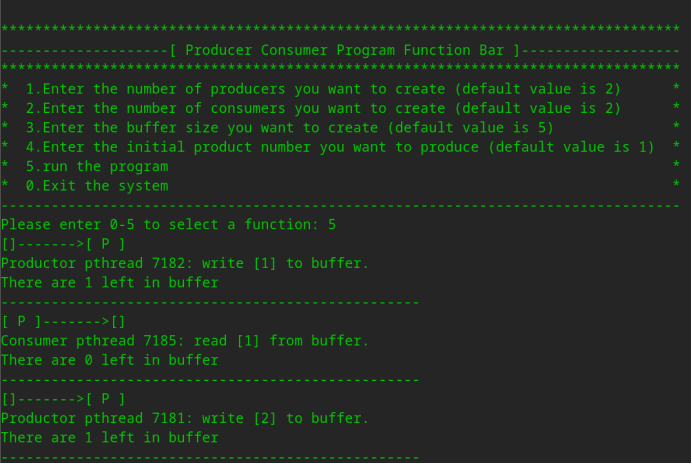
中间略
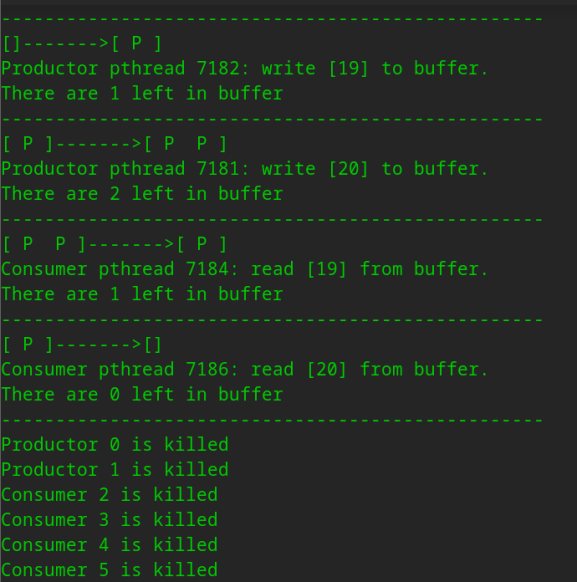
(2)示例二,这次运行我们想将缓冲区大小改为7,商品初始编号改为300,其余选项为默认值,运行程序。
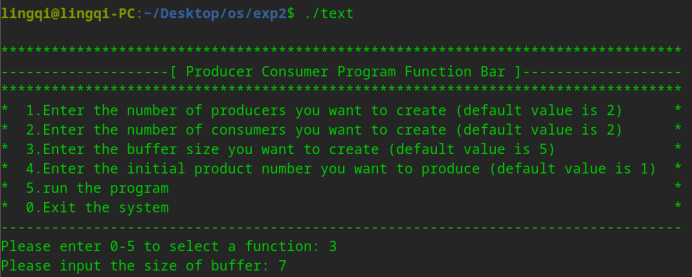
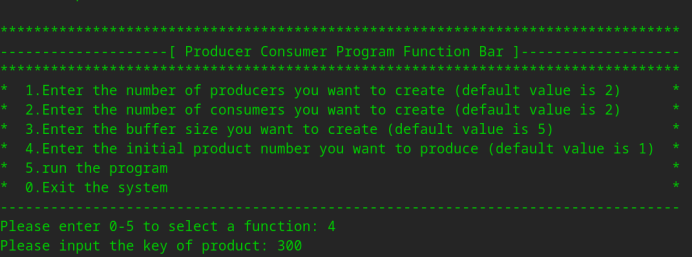
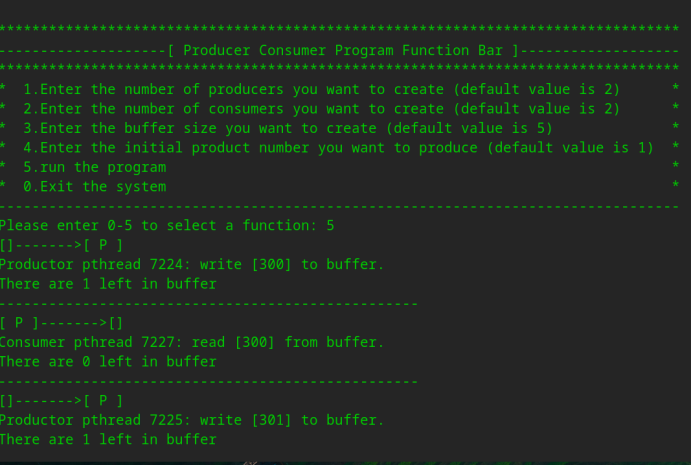
中间略

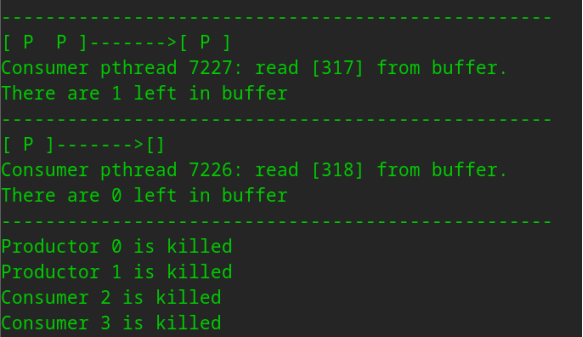
5. 总结
实验中遇到的问题与解决方法:
****问题1:****想要改进程序执行语句,使程序运行时能反映出具体是哪一位生产者/消费者 生产/消费 了哪一个商品。一开始我尝试在pthread_create()函数中给生产者/消费者函数传递生产者/消费者id变量,但是由于线程共享变量,无法在生产者-生产者、消费者-消费者之间作出区分。
****解决方法:****最终我决定使用gettid()函数获得生产者、消费者的线程id,作为每一位生产者/消费者的标志,来反映出具体是哪一位生产者/消费者 生产/消费 了商品。
****问题2:****在程序运行过程中,缓冲区中的产品变化并不能被很好的反映出来。
****解决方法:****我编写了display()函数,分别在生产/消费前后调用它,可视化了缓冲区中的商品状况。
****问题3:****程序不够灵活,并且界面对用户不够友好。想要实现用户能够简单自主地控制想要创建的生产者与消费者个数、缓冲区大小与产品编号。
****解决方法:****我使用了全局变量,在程序执行之初定义好默认值,并提供了与用户交互的接口,使用户能够自主改变程序运行的参数。编写了print()函数,优化了终端可视化界面,使用户能够自主选择想要改变何种参数,使程序运行更灵活直观。